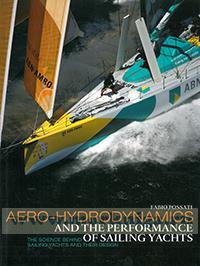Aero-hydrodynamics and the performance of sailing yachts
There are not many books around that deal with the theory behind sailing boats. And certainly not books that deal with both the aerodynamics and the hydromechanics involved at the same time. This despite the fact that quite a few scientists and researchers have been dealing with these topics.
So I was very pleased when I first saw this book written by Professor Fabio Fossati from Milan Polytechnic University in Italy.
Fabio is an established and very highly respected scientist in the field of aerodynamics in general, who has also a strong interest in sailing yachts and the aerodynamics associated with them. In recent decades he has published a considerable number of papers and publications on the subject of the sailing yacht, in particular on its aerodynamics. In addition he is also deeply involved in the development of VPPs used in the international yacht racing scene.
This book deals with all the aspects of the aerodynamics and hydromechanics of the sailing yacht, the underlying physics in general, the experimental techniques used, the available calculation, approximation and assessment methods and items such as manoeuvrability and control. The author deals with the subjects in significant detail. In addition all this is written in a scientifically justified and yet very understandable and well explained manner. A perfect book aimed at the general public and maybe more specifically to (university) students. It will certainly become a handbook for those who want to know more about the fascinating phenomenon and scientific challenge that the sailing yacht still is up to the present day.
At that time, however, there was only one drawback: the book was in Italian.
So I was very pleased when Fabio told me he was considering translating the book into the English language and I offered assistance if needed.
This new edition is now in English and fully updated by Professor Fabio Fossati with the newest information about the relevant scientific research results available around the world. Both in aerodynamics and in hydromechanics, as well as all the associated areas of interest, the book is fully up to date.
I recommend this book to all readers wishing to improve their insight and maybe also their 'operational' capabilities (sailing skills) - if still possible, of course!
Содержание
Preface to the English Edition
Preface to the Original Italian Edition
Introduction
CHAPTER ONE
The Physical Model of Yacht Motion
1.1 The motion of a yacht
1.2 Physical model and equilibrium
CHAPTER TWO
The Hydrodynamics of a Sailing Boat
2.1 Flow around the hull: interaction phenomena
2.2 Breakdown of total resistance
2.3 Frictional resistance
2.4 Wave resistance
2.4.1 The Froude number
2.4.2 Relative speed
2.4.3 Relative (or specific) wave resistance
2.4.4 Factors influencing wave resistance
2.4.4.1 The prismatic coefficient Cp
2.4.4.2 The volumetric coefficient Cv
2.4.4.3 Beam-draft ratio
2.5 The Delft series
2.6 Wave resistance computation
2.6.1 Influence of overhangs
2.7 Sensitivity analysis of the influence of various factors on wave resistance
2.8 Heeled resistance: basic concepts
2.8.1 Heeled resistance computation
2.9 Water planform interaction: the wing section theory
2.10 Tip induced drag
2.11 Appendage hydrodynamics
2.12 The hull polar plot
CHAPTER THREE
Hull and Keel Forms
3.1 Evolution of hull forms
3.2 Methods and tools for hull surface modelling
3.3 Hull appendage design
3.3.1 Families of NACA airfoil sections and their characteristics
3.3.1.1 NACA 4 digit airfoils
3.3.1.2 NACA 4 + 2 digit airfoils
3.3.1.3 Laminar NACA airfoils
3.3.1.4 An example of characteristic curves of NACA airfoils
3.3.2 Keel design
3.3.2.1 Influence of shape on section characteristics
3.3.2.2 The aspect ratio
3.3.2.3 Appendage tip shape
3.3.2.4 Free surface effects
3.3.3 Some useful NACA airfoil sections
3.3.4 Operational conclusions
CHAPTER FOUR
More About the Hydrodynamics of a Sailing Boat
4.1 Calculating dynamic actions on the hull appendages
4.1.1 Appendage resistance in upright conditions
4.1.2 Change of residuary resistance due to heel
4.1.2.1 Residuary resistance of hull appendages in the presence of heel
4.1.2.2 Hull appendage induced resistance in the presence of heel
4.2 Added resistance in waves
4.2.1 Sea state and wave characteristics
4.2.2 Yacht motion in waves
4-2.3 Evaluating added resistance in irregular waves
4.3 Propeller resistance
4.4 Summary of resistance components
CHAPTER FIVE
Sailing Boat Aerodynamics
5.1 The aerodynamics of the sail
5.2 From cambered foils to real sails
5.3 The aerodynamic forces acting on the boat
5.4 Sail aerodynamics
5.5 Sail drag
5.6 the geometry of sails
5.7 Sail interaction
5.8 Aerodynamic forces on the hull and rigging
5.8.1 Evaluating hull and superstructure windage
5.8.2 Evaluating rigging windage
5.9 Whistling in the rigging
CHAPTER SIX
Steady State Dynamics of a Sailing Boat
6.1 Estimating the speed of the yacht
6.2 Estimating the heel under sail
6.3 Estimating the sail area
6.3.1 The Dellenbaugh angle
6.3.2 Estimating sail plan area with traditional methods
6.4 Equilibrium under sail: estimating the surface area of hull appendages
6.5 Yacht performance and stability
CHAPTER SEVEN
More About Sailing Yacht Dynamics
7.1 The rudder: basic concepts
7.1.1Yacht steering performance: manoeuvrability and course stability
7.2 Directional stability: balance
7.2.1 Some practical considerations on lead
7.2.2 More about yaw balance and evaluating hydrodynamic side force
7.3 Yacht steering performance: manoeuvrability and course stability
7.4 Dynamic effects on the hull and sails
7.5 Dynamic stability: self-excited downwind rolling
7.6 Roll induced by the rudder
7.7 Dynamic stability in breaking seas
CHAPTER EIGHT
Physical Model Testing
8.1 Historical notes
8.2 Facilities and approaches
8.2.1 Types of facilities and their uses
8.3 INSEAN and the Milan Polytechnic wind tunnel facilities
8.3.1 The INSEAN towing tanks
8.3.2 The Milan Polytechnic wind tunnel
8.4 Scaling problems in using models: similitude laws
8.5 Towing tank test techniques: Froude's hypothesis
8.5.1 The Prohaska method
8.6 Tank testing models
8.7 Measurement set-up for towing tank tests
8.8 The boundary layer in scale model tests: turbulence stimulators
8.9 Flow visualisation techniques
8.10 Towing tank tests of sailing boats
8.10.1 Towing tank test techniques: captive and free towing methods
8.10.2 Semi-captive models
8.10.3 Measurement problems with semi-captive models
8.11 Systematic yacht hull series
8.11.1 Methods for systematic variation of hull shape
8.11.1.1 Stretch
8.11.1.2 The Lackenby method
8.11.1.3 Control point network (NURBS -B-Spline - Bézier)
8.11.2 Experimental data analysis
8.11.3 An application: the Il Moro di Venezia America's Cup challenger
8.12 Wind tunnel tests of sailing boats
8.12.1 Sail plan testing methods
8.12.2 Test apparatus and measurement set-up
8.13 Test procedure for close hauled sailing
8.14 Test procedure for downwind sailing
8.15 Evaluating windage
8.16 Optimising sail plan
8.17 Similitude problems in wind tunnel testing
8.18 General notes on hull appendage wind tunnel testing
CHAPTER NINE
Performance Prediction
9.1 Sailing boat states of equilibrium
9.2 Velocity prediction programmes (VPP)
9.3 Predicting performance
9.4 Force modelling
9.4.1 The hydrodynamic model
9.4.1.1 ORC International VPP hydrodynamic model
9.4.2 The aerodynamic model
9.4.2.1 ORC International VPP aerodynamic model
9.5 Solving equilibrium equations
9.6 Presenting output
CHAPTER TEN
The Use of Numerical Methods in Yacht Design
10.1 Numerical methods for structural analysis
10.2 Numerical methods for fluid dynamics analysis
10.3 The frontiers of numerical methods: aeroelastic investigation
APPENDIX ONE
Elements of Fluid Mechanics
A.1.1 Fluids and their properties
A.1.1.1 Density and viscosity
A.1.2 Interactions between fluids and solids
A.1.2.1 The Reynolds numbe
A.1.2.2 Vortex shedding
A.1.3 Dynamic actions
APPENDIX TWO
Elements of Boat Hydrostatics
A.2.1 Hull floating: trim
A.2.2 Floating equilibrium: stability
A.2.3 Static stability
A.2.3.1 Metacentre and metacentric radius
A.2.3.2 Calculating the metacentric radius
A.2.3.3 Experimental assessment of the metacentric height
A.2.4 Initial stability slope
A.2.4.1 Roll stiffness
A.2.5 Calculating the righting moment
A.2.6 Statical stability curve
A.2.7 Set-up of the stability curve
APPENDIX THREE
The ORC International Rating Rule
A.3.1 Introduction
A.3.2 The ORC International Rating Rule
A.3.2.1 Hull measurement and lines processing
A.3.2.2 Performance prediction
A.3.2.3 Race scoring
A.3.3 Managing the ORC International Rule
References
Photographic credits
Index

 Русско-английский тематический словарь яхтсмена
Русско-английский тематический словарь яхтсмена  Прогноз погоды здесь и сейчас
Прогноз погоды здесь и сейчас  Яхта в районах интенсивного судоходства - рекомендации по применению МППСС-72. Практическое пособие для яхтсменов
Яхта в районах интенсивного судоходства - рекомендации по применению МППСС-72. Практическое пособие для яхтсменов